Many tariff plans for the Internet from mobile operators have restrictions on the amount of data received, but even if you use unlimited tariff With this plan, the operator can throttle the data transfer rate after a certain amount of data has been exceeded, usually per day.
Nowadays, the smartphone has to download more and more data due to the fact that many applications use the Internet, not to mention social media, media resources, web services, and mail checking. So what is the right way to use tariffs with a limit on the amount of data transferred? A few tips to help rethink habits, control traffic usage and empower tariff plan so that you never again pay more than the cost of the fare.
1. The control
Before you start trying to reduce traffic consumption, you need to clearly understand how much traffic is usually used. The only way to find out is to monitor and monitor traffic usage. This is the only way to understand how much data passes through the phone even when it is not used and is occupied only by background processes.

There are several ways to track data usage on Android device or iOS. The easiest is to look at the statistics on the device itself. It is necessary in the "Settings" menu to go to the "Wireless and Networks" section and select the "Usage Data" item to get an interactive graph that displays how much data has been used during the last month. In addition, it is useful to look at statistics for previous months, as well as a list of applications that use the data to check their consumption.
The amount of data usage on the device can be additionally checked third party applications for comparison with the data provided by the operator. Some applications provide monthly data usage reports and consumption analysis.
2. Prevent applications from receiving traffic
iOS 7 and Android can disable certain apps from using data over the cellular network, allowing you to connect only when you have a Wi-Fi connection. This can be especially useful when installed applications consuming a lot of traffic.

On the iPhone, in the application settings mode, the Cellular menu shows the amount of traffic consumed, but only since the last reset of the settings. If you do not reset the statistics for each new payment, it will not make much sense. There is also a switch next to each application - to stop using mobile traffic, you must turn it off.
3. Use Wi-Fi instead of mobile data
If there is access to Wi-Fi, then using it will save a significant share of mobile traffic, thereby pushing back the threshold for exhausting the mobile Internet limit or reducing speed. However Wi-Fi usage can drain the smartphone battery a little faster. Find stable and free wifi network may not be easy. In this case, using search programs such as "JiWire's Wi-Fi Finder" available for both Android and iOS can help. "JiWire's Wi-Fi Finder" contains a database of 550,000 WiFi hotspots in 144 countries.
4. Avoid streaming video or music
It's probably obvious that audio/video streaming requires significant amounts of data to be transferred, so reducing or eliminating such resources can significantly reduce mobile traffic consumption.

Podcasts, music or videos can be downloaded to the device in advance and thus not downloaded from the Web while listening, but used locally. When listening to music over the Internet, you can save some money by controlling the bitrate (sound quality) at which it is transmitted.
5. Check which applications use a lot of traffic
Do not forget about other applications that use a lot of traffic: social networks that are constantly updated in background, games downloading updates and notifications, cloud storages such as Dropbox or Google Drive trying to sync files - all this can use up the data limit too quickly and without your knowledge.
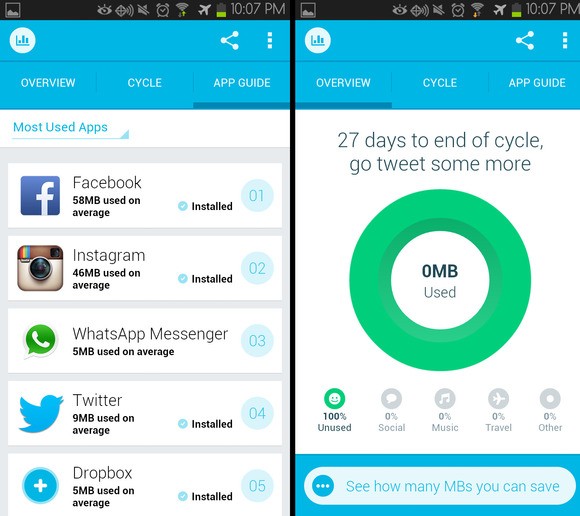
Another way to reduce traffic is to use "light" applications for everyday tasks, for example, you can use a browser to browse pages. Opera Mini, which compresses the data. In the browser, you can disable viewing graphics if only text data is enough, which "weigh" much less than pictures.
6. Disable background app updates
Android and iOS allow apps to update data via cellular communication in the background. And if you have several dozen applications installed, they will be updated almost every day.
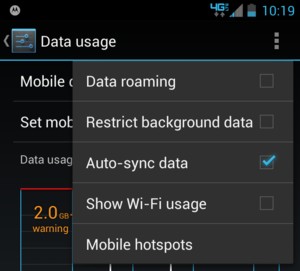
You can disable auto-updates on the Android platform in the application settings mode "Data Usage - More Settings - Restrict background data". This will not limit data reception when connected to Wi-Fi, but will save mobile traffic. In addition, Android allows you to limit background data usage on a per-app basis.
7. Set traffic consumption limit
On Android, you can set an arbitrary traffic consumption limit based on the data of the tariff plan, so as not to overpay for the amount consumed in excess. In this case, when the threshold is reached, applications will use the Internet only via Wi-Fi. This is configured in the "Settings - Data usage - Set mobile data limit" menu. After enabling the option, you must specify the value of the mobile data limit.

8. Turn off auto-sync
On iOS, you can take steps to disable synchronization with remote servers using the "Settings - Wireless and network - Data usage" setting. In this mode, the "Auto sync data" setting should be disabled. You can turn off background updates for apps such as Dropbox, Facebook, Google, LinkedIn, and Twitter in the "Settings - Accounts" menu, then select the account you want to restrict.
9. Limit automatic updates
Both iOS and Android have the ability to download and install app updates. For iOS control This feature is performed in the "Settings - iTunes & App Store" menu by switching the "Cellular Data" flag to the "off" position. For Android platforms the corresponding option is in the menu " Google Play- More settings - Settings - Auto-update - Auto-update over Wi-Fi only".
Manufacturers of modern mobile devices are trying to outdo their competitors by offering consumers a wide range of trendy gadgets. Cell Phones occupy a large share in the list of such products and are in deserved demand of the population. Modern phones equipped large quantity applications and programs and allow you to access the Internet at a convenient time and anywhere. And it is absolutely not necessary to know all the subtleties and capabilities of such phones, but you still need to have an idea and be able to use their main functions.
For example, all modern models of mobile devices have the ability to access the World Wide Web. Some of the phones may only support standard programs online communication, but smartphones are able to provide an excellent connection to the Network and uninterrupted activity a large number applications. Therefore, the settings of many smartphones make it possible to go online by default and download the necessary updates.
Shutdown of the Internet will help to avoid unexpected expenses
If Internet traffic is expensive or has a limit, as well as if the battery is low, the available resources may end at the most inopportune moment. For example, a trip abroad is planned. As you know, abroad such a pleasure as traffic due to roaming will cost a tidy sum.

Or there was a need to reduce battery consumption, or maybe you just want to take a break from the information flow that flows from the expanses of the virtual network.
Modern mobile devices already have an automatic function of regularly updating applications without the knowledge of their owners and performing a number of actions using precious minutes of traffic. In order to turn off such functions, you just need to perform a few simple manipulations.
Let's figure out how to turn off the Internet on your phone and limit the output of your mobile device to the World Wide Web
Steps to Disable Internet on Android Device
- We enter the control panel located at the top of the screen. First, check the status of the icons: WiFi, GPS, Mobile Internet. The illuminated icon indicates that these functions are active. To disable or enable the connection, you just need to select the appropriate icon with the required value.


- We enter the main menu and click on the "settings" icon. Here we select “wireless networks” from the menu that appears and set the checkbox opposite the item we want to remove to the “off” position.
- In this way, you can disable access to the Network while roaming and data exchange by making a selection on the corresponding value in the menu. To turn off all connections, it is convenient to use "airplane mode" by selecting it from the task menu at the top of the screen. In some devices, the flight mode selection menu can be accessed by holding down the power button for a long time. In this case, the menu will open:
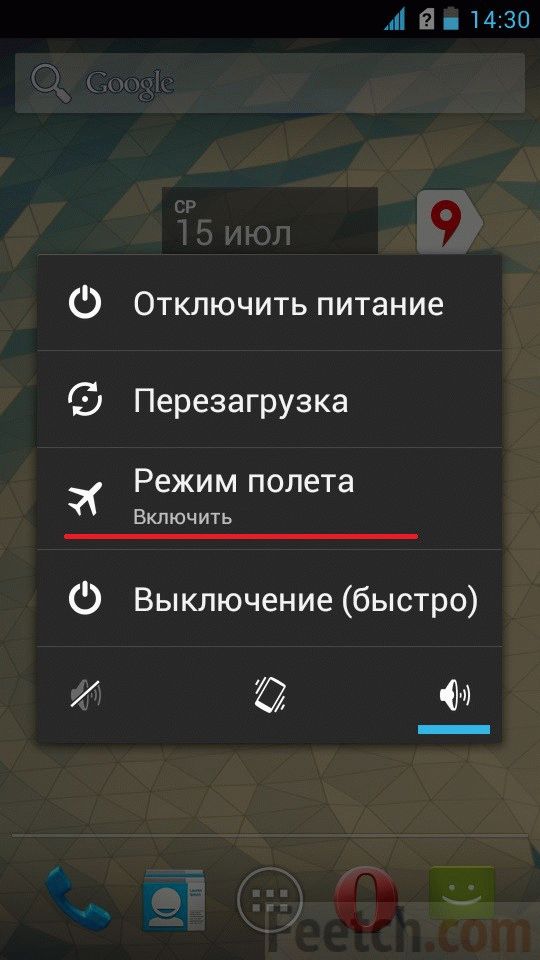
- You can also install an Android app on your device to help you manage your connections. Such programs allow you to disable access to the network with a flick of the wrist.
Shutdown on Windows Phone
There are several ways to disable traffic on platforms Windows phone 7 and 8. The methods here are exactly the same. We go into the menu and find the settings icon. Then we find the item "data transfer" and set the checkbox in the "off" position.
You can also use the flight mode. In this mode, both data reception and transmission of all external radio signals are stopped. This also applies to Wi-Fi, GPS, mobile Internet. Just in the settings you need to find "Airplane Mode" and drag the slider to the "On" position. The status bar should show an image of the aircraft.
If you need to disable the Wi-Fi function, open the “settings”, select the appropriate menu item and check the box in the “off” position.

Turn off internet on ios for iphone and ipad
To turn off 3G Internet and data transfer, go to the "Settings" menu and set the slider opposite cellular data to the leftmost position. You can also go below and opposite the items 3 G and data roaming by selecting the appropriate menu item, disable unnecessary functions using the slider.
Previous firmware versions provide a slightly different course of action.
- Open the "Settings" item and select "General". Then, having opened the "Cellular Data" section, set the checkbox to the "off" position.
- To turn off wi-fi, open the "settings" line in the main menu and select wi-fi, then move the button to the left.
- Just like other operating systems, ios has an Airplane Mode feature. In order to enable it, you need to move the slider in the "Settings" menu to the extreme left position next to the "airplane mode" item.
The function of accessing the Internet is also disabled by contacting the operator mobile communications, regardless of the brand of your phone and the operating system you have.
Tablets and USB-modems, and more recently smartphones, are bought for the sake of Internet traffic, because now mobile Internet is used almost more often than at home. However, you may have reasons to turn it off, such as a desire to save money. Let's talk about the basic methods.
Ways to turn off the Internet
1. Deactivation of the "Package of three services"
The "Package of three services" from "Beeline" includes Mobile GPRS-Internet, WAP and MMS. By disabling it, you will not only not be able to use the Internet on your mobile, but also send MMS.
Like all options and services, the easiest way to disable the “Package of three services” is in your Personal Account or the My Beeline mobile application.
You can also do this by sending a USSD code to the number *110*180# or calling the operator at the number (mobile).
2. Deactivation of service packages related to the Internet: Highway, change of tariff plan with an unlimited Internet package, etc.
In your Personal Account or the My Beeline mobile application, you can at any time check which tariff and which Internet services you have connected. Here you can turn them off.
From the report in your Personal Account, you will always understand how much was spent on the Internet at home, how much in Europe, and how much, for example, when traveling to Kazakhstan.
3. Turning off the Internet on the device itself
In the phone or tablet settings, in the "Wireless networks" section, you can delete all profiles, Accounts and other data. But the next time you turn on the device, the new settings will be automatically sent by the operator to the SIM card.
Therefore, if you want to turn off the Internet on the device, you will need to get into the phone settings.
On Apple devices:
Open "Settings", go first to the "General" section, then "Network" and move the switches for "Enable 3G" and "Cellular Data" to the "0" position. After that, the iPhone will not be able to access the Internet via GPRS and 3G channels.
On Android devices, the path may vary depending on the manufacturer. Approximately it will be like this:
Section “Settings wireless networks», « Mobile networks” or “Mobile Internet” will allow you to configure access to the network via GPRS. Uncheck the "Enable Packet Data" option.
4. Voluntary blocking for a temporary period
Voluntary blocking allows you to turn off the Internet for 90 days on both Android and Apple devices. After 90 days, network access is activated automatically. The service is connected through the Personal account or by number 8-800-700-8000 .
Turning off the Internet on a USB modem
If you stop using the modem, access to the network will automatically stop when you reach a completely zero balance, and the balance will not go negative. After replenishing the account, the Internet on the modem can be used again, a special command is not needed.
If you want to give up forever USB usage modem, you can simply remove its driver. To do this, go to the "Control Panel", then to the "Programs and Features" section, select "Beeline USB modem" and click the "Delete" button.
Hey! Although the number of gigabytes included mobile operators in their tariffs is growing every year (and there are already completely unlimited solutions), and the price, on the contrary, is falling, anyway, not many can afford to fully unlimited Internet on the device. Yes, and here it’s rather not a matter of “allowing”, but simply not many people need it. There is a conditional one gigabyte per month and it is enough - why pay more?
But in some cases (especially when switching to an iPhone from another device), these same gigabytes suddenly begin to be missed - when turned on, Apple's mobile phone starts wildly eating traffic and eats up all available limit in a few hours. And this is where the screams begin: “The iPhone is bad, I just inserted a SIM card - I don’t do anything, and the traffic goes away on its own (and the battery is also running low!)”. Ai-ai-ai and all that...:) Why is this happening? Believe me, not because the iPhone is bad and the company decided to ruin you, no.
The thing is that the iPhone, like any modern smartphone there are a number of settings that you just need to pay attention to in order to avoid such “arbitrariness” of your smartphone with your own Internet.
But first, a small list of where iPhone traffic can go without your knowledge:
An experienced reader and user will say: “Yes, there is still a lot where traffic can flow!”. And he'll be right - updates mailboxes, push notifications, browser, etc. all this also affects the number of gigabytes consumed, but:
- Say that push notifications, mail downloads, etc. downright strongly devour the entire cellular Internet - it is impossible. They use it, if at all, in very small quantities.
- And if you turn all this off, as they suggest on many sites (the most ingenious advice I have come across is not to turn off the Internet in the settings so that it does not waste you), then why then the iPhone?
Therefore, let's try to get by with a little bloodshed - we will prohibit the iPhone from consuming the Internet on its own, but without much damage to us.
Update or download apps from the App Store
Current applications and games can reach 2-3 gigabytes in size, and Apple has taken care of saving traffic - officially download a program with a volume of more than 100 megabytes from app store it is impossible (though we know something). But at the same time, there is a large number of programs smaller than this 100 MB threshold. And that's it they can devour your Internet package.
Here we are talking not so much about downloading (you see what you are downloading), but about updating these programs on your own via a cellular network. Therefore, such an update must be disabled:
That's it, now the programs will no longer use the cellular network for their update, and will only do it via Wi-Fi.
How to find out which application is eating traffic on iPhone
Installed programs, in addition to simply updating their version, can consume the Internet in order to perform their usual functions. Therefore, if you really feel that megabytes are running away, it makes sense to check - or maybe some application is too "snuffed"? You can do this:

Just in case, remember this moment so that in the future you will not be surprised why these cards (for example) refuse to work and update their data.
Sending "service information" can also waste the Internet
In fact, of course, this option does not consume mobile Internet so much and I myself have not encountered this, however, I have seen several stories that tell about this particular “glitch”, or a failure, when this very service information was sent constantly. Therefore, I decided to include this item here - it will not be superfluous to disable sending it for sure. How to do it?

As we see in the explanation, this information is sent daily, and does not carry any special load, apart from the fact that we help Apple improve products. Therefore, if you turn off its transmission, then nothing terrible will happen, and traffic (even if small) will be saved.
"Help with Wi-Fi" - traffic on the iPhone leaks very quickly
"Wonderful" option, which is enabled by default for some reason. The point is that if your wifi signal"does not pull", and the cellular network can provide the best speed - Wi-Fi will automatically turn off and data transfer will go through the SIM card.
I myself fell for this bait not so long ago - I sat watching videos on YouTube, did not bother anyone. Then the iPad didn’t like something in my Wi-Fi (bad signal, insufficient speed) and he considered it necessary to turn it off (which is important - no notifications come!), And I, in happy ignorance, continued to enjoy the video via cellular connection. I came to my senses only after the operator sent an SMS message with the text: "Your Internet package is coming to an end."
Therefore, in my opinion, if you do not have an unlimited tariff, this option should be disabled immediately. How to do it:

I repeat, this option should be turned off in almost any case, so that there are no surprises with the disappearance of traffic.
iCloud services sync eats up mobile data
iCloud is really good and convenient as well backups so generally beyond praise. However, if you care about saving precious megabytes on your tariff, then in this case the "cloud" will have to be turned off.
It is now about iCloud Drive- it's kind of cloud storage data (I already have about the principles of its operation). So, synchronization (downloading and uploading data) with this storage can occur over a cellular network. And it’s good if you sent a small object there, but what if it’s 100-200 megabytes? While it is downloading, all traffic will go away.
Yes, and ordinary programs can store their data there. And who knows how much they will load there? But it's good that all this can be turned off:
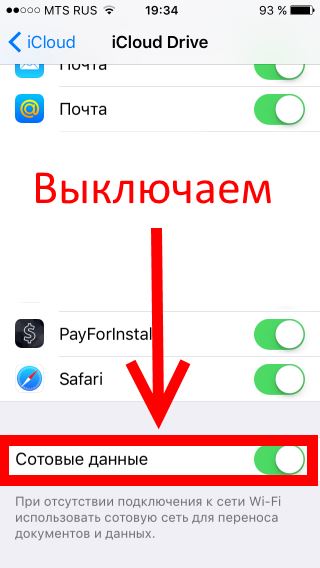
After that, the "cloud" will synchronize exclusively via Wi-Fi.
It would seem that each of the actions is quite simple and does not require much effort. But shutdown and execution of all items.
Using the mobile Internet, you receive and send megabytes of information every day - while browsing email, reading news sites or chatting with friends. In such a cycle, it is sometimes difficult to notice that the amount of traffic you are entitled to is spent somehow wrong. The fact is that your mobile, or rather the applications installed in it, can use the Internet without your participation. Let's figure out how to disable traffic.
You may have had to receive so-called push notifications more than once - short messages that remind you of some events. When sending push notifications, programs need Internet access, and since most users have this option mobile applications, the traffic is slowly eaten up. In order to prohibit such messages, you need to enter the "Settings" section, then "Applications", find the corresponding application and uncheck the "Notifications" line. You can go the other way: as soon as you receive a push notification, go to the notification panel and hold your finger on the line with it - the inscription "About the application" should pop up. Click it and in the window that opens, change the settings in the same way. Convenient widgets informing you about the weather, book releases, etc. also periodically go online in search of relevant information and updates. Therefore, it is better to remove widgets that you do not need at all.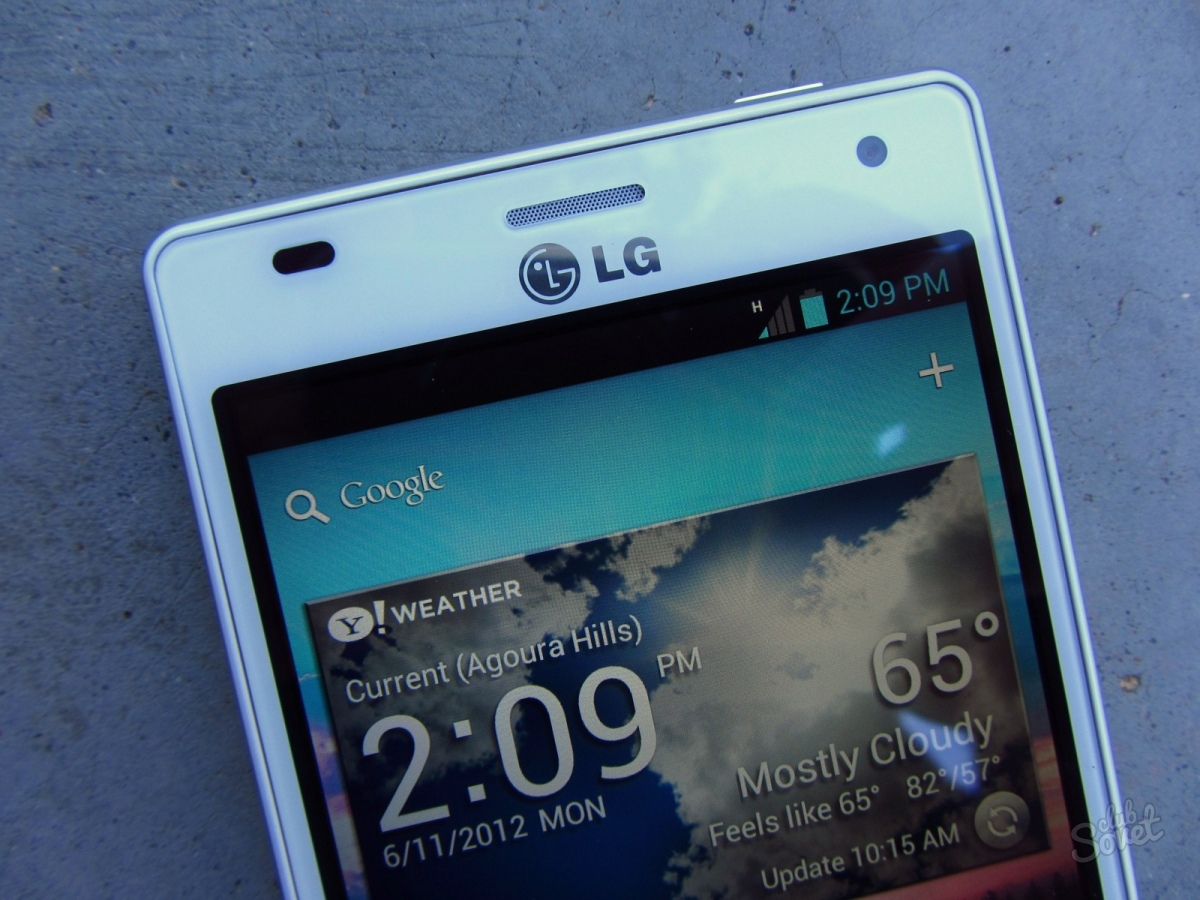


Now you know how you can save Internet traffic. And if you do not plan to use Internet services in the near future, the operator can disable them at your request.
